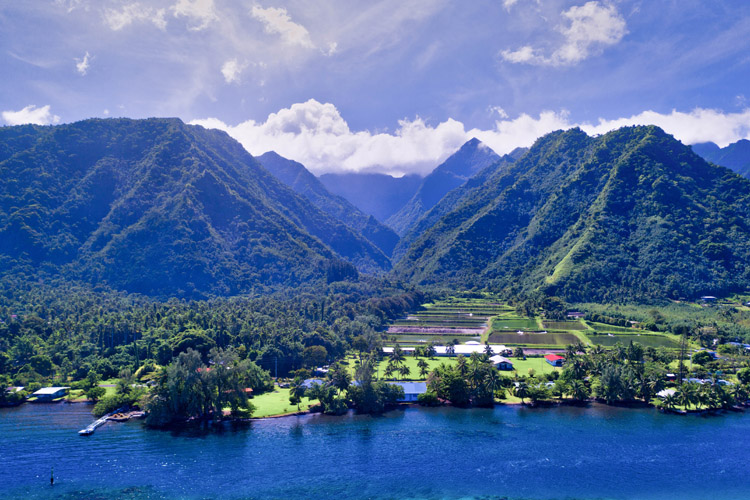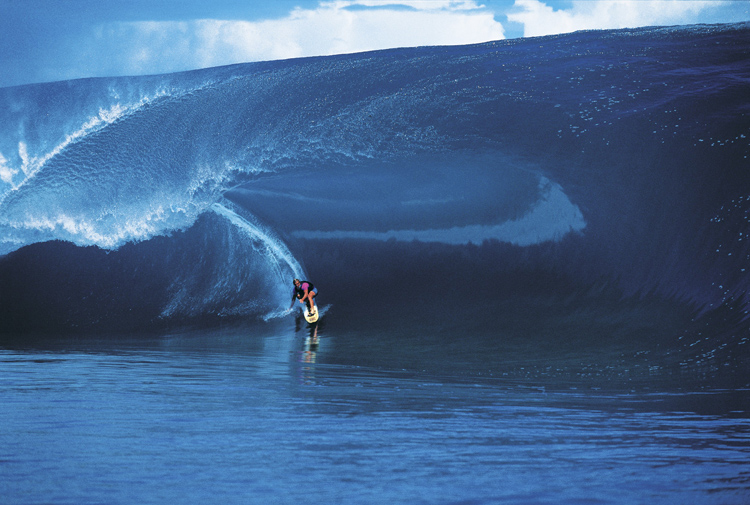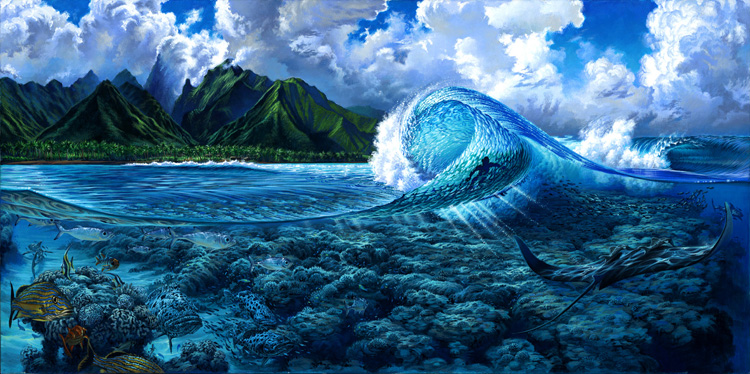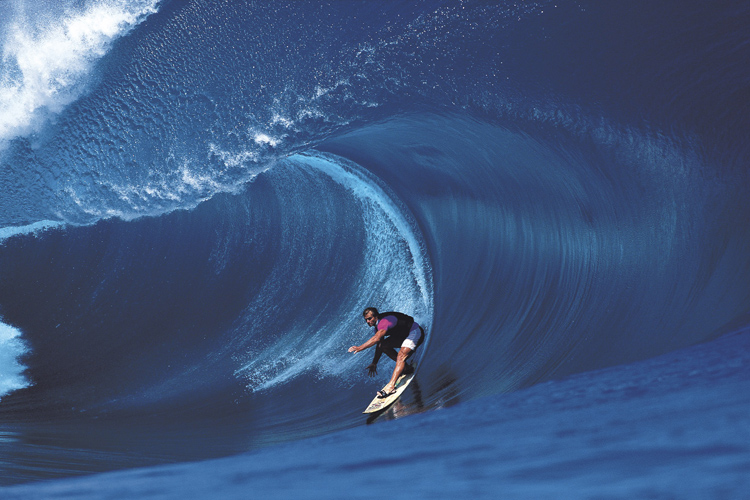Laird Hamilton is a key personality in the development of big wave surfing. On August 17, 2000, he rode one of the meanest and thickest waves on the planet. This is the story of the Millennium Wave.
Half Hawaiian, half Californian, Laird Hamilton pioneered the birth of tow-in surfing and participated in some of the most epic XXL sessions in the history of the sport.
Known as a swell hunter, the waterman has never stopped pushing the boundaries of surfing, specifically of what is considered surfable.
The first person to ever surf Tahiti's Teahupoo was Thierry Vernaudon, a local wave rider.
He rode it in 1985. It's a wave with a fearsome reputation and has already been called a "freak of hydrodynamics."
One year later, in 1986, Mike Stewart and Ben Severson tasted the power of the beast and spread the word throughout the surfing community.
By the early 1990s, Teahupoo was already on the pro surfing radar, but it was only in 1999 that the left-breaking monster got included in the 1999 ASP World Tour calendar.
Mark Occhilupo won the first-ever Gotcha Tahiti Pro after defeating CJ Hobgood in the final and ended up taking the world title that year.
Hamilton had already had his eyes on the mutant wave. In a way, the Tahitian reef pass reminded him of Jaws and its raw power.
But, as always, the talented daredevil wanted more.

The Day That Changed Surfing Forever
In August 2000, European sportswear company Oxbow traveled to the Pacific reef break with its legendary team rider to film his training for the upcoming winter surf in Hawaii.
Little did they expect the incredible surf session that they were about to be confronted with.
"The trip started off with a week of perfect 10-foot waves at a right-hander up the coast," photographer Tim McKenna tells SurferToday.
McKenna organized and shot the trip with Laird. He rented two fishing boats for the production and had two experienced fishermen positioning the crew perfectly close to the wave.
Hamilton and the group of media professionals arrived at the scene of the crime, fully aware of what they were looking for.
But in the back of their mind, they knew that a surfer had died the week before at the "End of the Road."
"As the swell kicked in even stronger, our team decided to challenge the famous Teahupoo break. Laird's fascination with the wave was obvious after his first few rides. For two days, he pulled into some of the deepest and biggest tubes ever ridden," recalls McKenna.
"As the swell dropped and the films were being processed, it gave us time to reflect on the possibilities of this wave."
"As Laird scrutinized the slides, I could see that he was still not satisfied with his performance. He wanted to go bigger and deeper now that he had a better comprehension of the mechanics of the treacherous wave."
"We were ready to leave Tahiti as news of another bigger swell was approaching. So we decided to stay. We knew it was going to be heavy but never expected anything like this."
A Big and Glassy Morning
On August 17, Laid Hamilton woke up and watched Teahupoo unleashing the first bombs of the day from the channel. It was big and glassy.
"We set off at 4:30 am that morning, amping with anticipation. Our two filming boats and two tow-in jet skis cruised through the Teahupoo reef pass at dawn," explains Tim McKenna.
"The swell was big and dangerous due to its west direction. Every glassy tube was spitting and imploding on the last bowl section."
"Before they headed off into the lineup, Laird Hamilton and his tow-in partner Nelson Kubach took a few minutes to pray. They knew that they were going to be up against the most dangerous conditions ever surfed."
"At 8:30 am, the first big set rolled in. Nelson drove the jet ski into position, but at the last moment, Laird called him off the wave. It was low tide, and the massive amount of water dredging on the reef was warping the wave."
"It was a split-second decision that probably saved his life. He decided to start off on some smaller waves just to get some rides under his belt. A couple of deep barrels later, and Laird was ready for the big ones," notes McKenna.
Veteran surf movie director Jack McCoy was also on the back of a jet ski, ready to capture everything. After a couple of warm-up waves, Hamilton fell on a medium-sized wave.
But things could only get better. A few minutes later, at 11:38 am, Hamilton rode the mother of all waves, on his backside.

The Time Is Now
A rogue wave twice the size of the regular waves rolled in.
After being launched from 50 yards farther up the reef, Laird let go of the rope, angled his board perfectly toward the channel, and started to speed down the face of the wall.
The thick blue 20-foot cylinder created a huge tube, and Laird accelerated down the line at full throttle, adjusting his board and body position before shooting himself like a cannonball through the tube.
His line and survival stance was perfect.
"The spit of the wave made him disappear as all the boats and film crew scrambled out to sea so as not to get hit by the monster. As we were speeding out of the impact zone, we saw Laird appear out of a cloud of whitewater right next to us," reveals the surf photographer.
Laird Hamilton had just pulled in and survived the meanest tube ever surfed. His tow-in partner couldn't believe what had just happened.
"I towed him onto this wave. It was to the point where I almost said: 'don't let go of the rope.' But when I looked back, he was gone," said Darrick Doerner, the jet ski driver who towed Hamilton into "the" wave.
Around 20 privileged spectators started screaming in horror and joy.
"It's the most amazing surfing performance I have ever witnessed. After that wave, Laird went back to one of our boats to rest," says McKenna.
He was amazed, confused, and emotional. Then, realizing what he had just accomplished, Hamilton sat down, put his head in his hands, and meditated.
Some say the big wave legend even spilled a tear of emotion. Hamilton had understood the magnitude of his achievement.
A few weeks later, the stunt was labeled "Millennium Wave." Laird Hamilton had become the first surfing hero of the digital age.
"That day was pretty special because it was the first time any of us had seen such big conditions at Teahupoo. Laird's performance was mind-blowing," underlines Tim McKenna.
"I knew that what we were documenting would make all the surf magazine covers and would change big wave riding to some extent."
"At the time, I had been shooting surfing all around the world for over ten years, so I knew this day was special."

The Millennium Wave by Laird John Hamilton
Laird Hamilton took his time to process the Millennium Wave. Then, when he was ready to speak about it, there were only words of humility and gratitude.
"The biggest tube I had ever surfed used to be in Hawaii. As of right now, it looks like it's Tahiti," Hamilton revealed in the aftermath of that day.
"Sometimes, it's hard to measure a wave by its size. More than the magnitude, I think the tubes I had here in Tahiti were definitely the most dramatic to memory at this point."
"It caught me off-guard. I was unsuspecting. I thought I could get some incredible waves, but I didn't realize the magnitude of the surf that was here, the perfection of the location, and the variety and amount of good waves."
"I believe that we've yet to experience the ultimate day. I hope in the next 10 or 15 years that I'm able to ride a day that I'll probably never see again in my lifetime."
"I think that the only limits are the limits we put on ourselves. I think that there is really no limit to what we're potentially capable of riding as long as the equipment keeps evolving, and the evolution of our technique keeps evolving."
"If the conditions are correct, I think that there is no limit to the size of waves that can be ridden, as long as the storms make them."
The Millennium Wave changed human perception of what is possible from a surfing perspective. But it also changed Laird Hamilton.
"It softened some hard corners in my life. And I felt honored to be awarded something so magnificent that it made me appreciate what I've been able to have experienced and do," concluded the waterman.
